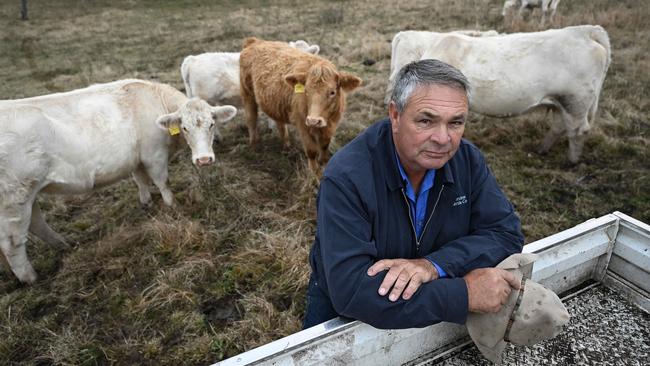ABARES modelling predicts 41 per cent fall in farm incomes
Farm incomes are expected to be slashed by more than 40 per cent, as drier conditions and a slump in commodity prices take their toll on primary producers.

Australian farmers are expected to have their incomes slashed by more than 40 per cent, as drier conditions and a slump in commodity prices take their toll on the country’s primary producers.
New modelling from the Australian Bureau of Agricultural and Resource Economics and Sciences (ABARES) predicts that average cash incomes for broadacre farms will drop by 41 per cent to $197,000 in 2023-24, following two record years that saw incomes peak at $350,000.
Falling beef, cattle and sheep prices are expected to hit the bottom line of livestock farmers, while drier conditions are expected to deliver lower yields across the country’s cropping regions.
While farm costs are expected to ease by 11 per cent in 2023-24, average revenue is expected to fall by 21 per cent due to the impact of lower yields and falling prices.
ABARES executive director Dr Jared Greenville said farm incomes were likely to slip back to levels experienced three years ago, with several regions likely to fall below their long-term averages.
“Livestock farms will be affected by large decreases in prices for beef cattle and sheep, with sheep farm incomes forecast to be well below average,” he said.
“We are expecting incomes well below the long-term average in parts of northern New South Wales and southern Queensland and the northern parts of the Western Australian cropping zone, mainly due to drier conditions resulting in lower crop yields.
“Incomes are also forecast to be well below average in parts of southern Victoria and South Australia, as well as parts of Tasmania and Western Australia, due to a combination of dry conditions and declining sheep, lamb, and wool prices.”
The new quarterly modelling undertaken by ABARES uses CSIRO production models and Bureau of Meteorology weather forecasts to predict how seasonal and market conditions are likely to affect Australia’s agricultural sector.
The latest figures are based on weather forecasts from early September, just before the Bureau of Meteorology formally declared another El Niño weather event, which is likely to cause more pain for farmers with drier and warmer conditions expected across most of southern and eastern Australia.
ABARES expects the drier conditions to cut agricultural production from $92bn in 2022-23 to $80bn in 2023-24.
The outlook adds to the current slump in confidence being felt across Australia’s agricultural sector.
Survey results released by the National Farmers Federation on Wednesday showed one in three farmers are less positive about the future than they were a year ago, with eight in 10 of the 1600 respondents concerned by federal climate change policies, biosecurity, the market power of processors and supermarkets, roads and transport infrastructure and overseas trading relationships.
Cattleman Ian Bebbington, who runs the Mountview Charolais bull stud at Cambooya, south of Toowoomba in Queensland’s Darling Downs region, said a slump in cattle prices, higher interest rates, and the drier outlook all posed a challenge for his operation.
The Eastern Young Cattle Indicator - a benchmark for cattle prices - dipped to 350c/kg this week, a new nine-year low and down 66 per cent from the same time last year.
“We’re getting affected by every one of those things,” Mr Bebbington said.
“We’re mostly stud cattle and it gets affected by the commercial cattle prices because as soon as the commercial cattle prices come down, the cattlemen don’t want to spend too much money on bulls obviously.
“It’s basically batten the down hatches. We won’t be buying any new machinery or doing any major improvements or anything like that until things improve a bit.”
More than half of the respondents to the National Farmers Federation survey say the federal government’s policies, including the planned shutdown of the live sheep trade, are “harming” the industry.
The Federation is one of several farming groups lobbying the federal government to rethink its plan to phase out live sheep exports, arguing it will hurt the local economy and harm Australia’s trade relationships with the Middle East.






To join the conversation, please log in. Don't have an account? Register
Join the conversation, you are commenting as Logout